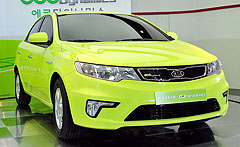Make / Model Search
Future models - Kia - Cerato - LPI HybridFirst drive: Kia goes gas for hybrid CeratoMild not wild: The Kia Forte (Cerato) LPI mixes hybrid technology with LPG injection to achieve 5.6L/100km. Kia Oz eyes ‘mild’ hybrid Cerato for LPG trials Down Under29 Jun 2009 By PHILIP LORD in SOUTH KOREA KIA is set to enter the alternative-powertrain arena with the August launch in South Korea of an LPG-injected ‘mild’ hybrid Cerato – known in its home market as the Forte – which might join the Cerato range in Australia as early as next year. The Forte LPI is the first fruit of Kia’s sub-brand, Eco-Dynamics, which showcases fuel-saving technologies such as idle-stop for conventional cars and hybrids, including the next-generation 2013 Magentis hybrid for the US market. The Forte LPI is closely related to parent company Hyundai’s gas-hybrid Elantra LPI. The group's 1.6-litre 85kW liquefied petroleum injection (LPI) engine is teamed with a 15kW ‘pancake’ electric motor sandwiched – Honda-style – between the engine and CVT transmission to assist acceleration rather than directly drive the wheels, as in Toyota's Prius. The Forte achieves a claimed 5.6L/100km on LPG, has a C02 output of 99g/km and has a 0-100km/h acceleration time of 11.7 seconds. By comparison, a conventional 93kW 1.6-litre Cerato has a fuel consumption figure of 6.6L/100km, C02 output or 163g/km and a 0-100km/h time of 12 seconds.  The Forte LPI employs a lithium-polymer battery, which is lighter and smaller but has higher output than nickel-metal hydride batteries, and is supplied by Korea's LG Chem. The Forte LPI employs a lithium-polymer battery, which is lighter and smaller but has higher output than nickel-metal hydride batteries, and is supplied by Korea's LG Chem.For better aerodynamics, a different grille and restyled front bumper with larger air intake and fog lights are used, and at the back, a redesigned rear bumper and LED taillights differentiate the hybrid model. Inside, the Forte LPI has additional instruments indicating the state of charge and electric motor operation. GoAuto drove the new hybrid at Kia’s Namyang research and development centre in Korea last week. Within the one-kilometre stretch on an arrow-straight test ground, the Forte LPI felt much like a normal Cerato, except that the conventional Cerato’s rise and fall though the four-speed auto is replaced with a banshee wail as revs are held via the CVT. The Forte LPI also has idle-stop, so you are greeted by silence as you roll to a halt. The LPG tanks are fitted ahead of the rear wheels and protected by a plate in the pre-production car we drove. The battery pack is under the parcel shelf in the boot. Kia expects 20,000 sales a year for the Forte LPI, and is considering main export markets such as China and the US, where it would be sold as a petrol-electric hybrid. Australia has a well set-up LPG infrastructure, but Kia’s plans to sell it here are in the early stages. Kia’s director of overseas marketing group Soon-Nam Lee said exports plans for Australia had not been decided. “We’re testing LP gas, trying to see what the differences are between Australian and Korean gas,” he said. While Korea has a well-established automotive LP gas infrastructure, the proportion of butane is much higher than in Australia, where butane and propane are generally in a 50-50 mix. Minor obstacles include the vehicle’s gas refuelling nozzle, which uses a different design in Korea. Kia Motors Australia public relations manager Jonathan Fletcher said Kia would build a right-hand-drive car for Australia evaluation as soon as the LPG issues had been resolved. “If it’s late this year that we get a car to evaluate, then early next year we could make the decision. Then it’ll take six months for homologation,” he said “Perhaps 12 months, but it’s not a given.” Sources close to the factory said the Forte LPI would command a premium of about $7500 over the conventional petrol model, but this figure did not account for an LPG concession the Korean government gave private buyers. Read more:First Look: Kia reveals LPG hybrid small carAll future models Alfa Romeo Alfa Romeo Abarth Abarth Alpine Alpine Alpina Alpina Audi Audi Aston Martin Aston Martin BMW BMW Bentley Bentley Chery Chery Brabham Brabham Chrysler Chrysler Chevrolet Chevrolet Cupra Cupra Citroen Citroen DS DS Dodge Dodge Fiat Fiat Ferrari Ferrari Foton Foton Ford Ford Great Wall Great Wall FPV FPV Haval Haval GWM GWM Honda Honda Holden Holden Hummer Hummer HSV HSV Infiniti Infiniti Hyundai Hyundai Jaguar Jaguar Isuzu Isuzu Kia Kia Jeep Jeep Land Rover Land Rover Lamborghini Lamborghini Lexus Lexus LDV LDV Mahindra Mahindra Lotus Lotus Mazda Mazda Maserati Maserati Mercedes-AMG Mercedes-AMG McLaren McLaren MG MG Mercedes-Benz Mercedes-Benz Mitsubishi Mitsubishi Mini Mini Opel Opel Nissan Nissan Peugeot Peugeot Pagani Pagani Proton Proton Porsche Porsche Renault Renault Ram Ram Rover Rover Rolls-Royce Rolls-Royce Skoda Skoda Saab Saab SsangYong SsangYong Smart Smart Suzuki Suzuki Subaru Subaru Toyota Toyota Tesla Tesla Volvo VolvoCerato pricingMotor industry news |
Click to shareKia modelsResearch Kia All future models Alfa Romeo Alfa Romeo Abarth Abarth Alpine Alpine Alpina Alpina Audi Audi Aston Martin Aston Martin BMW BMW Bentley Bentley Chery Chery Brabham Brabham Chrysler Chrysler Chevrolet Chevrolet Cupra Cupra Citroen Citroen DS DS Dodge Dodge Fiat Fiat Ferrari Ferrari Foton Foton Ford Ford Great Wall Great Wall FPV FPV Haval Haval GWM GWM Honda Honda Holden Holden Hummer Hummer HSV HSV Infiniti Infiniti Hyundai Hyundai Jaguar Jaguar Isuzu Isuzu Kia Kia Jeep Jeep Land Rover Land Rover Lamborghini Lamborghini Lexus Lexus LDV LDV Mahindra Mahindra Lotus Lotus Mazda Mazda Maserati Maserati Mercedes-AMG Mercedes-AMG McLaren McLaren MG MG Mercedes-Benz Mercedes-Benz Mitsubishi Mitsubishi Mini Mini Opel Opel Nissan Nissan Peugeot Peugeot Pagani Pagani Proton Proton Porsche Porsche Renault Renault Ram Ram Rover Rover Rolls-Royce Rolls-Royce Skoda Skoda Saab Saab SsangYong SsangYong Smart Smart Suzuki Suzuki Subaru Subaru Toyota Toyota Tesla Tesla Volvo VolvoCerato pricingMotor industry news |









Facebook Twitter Instagram